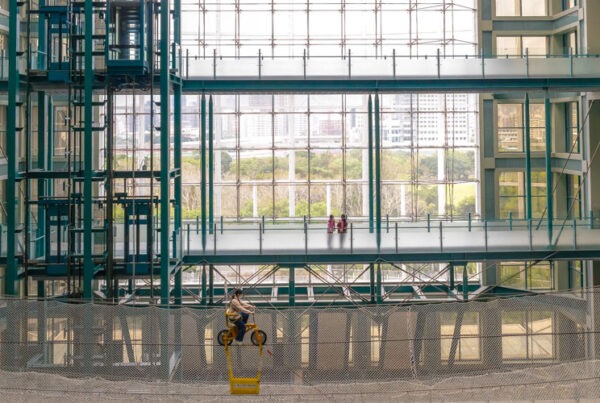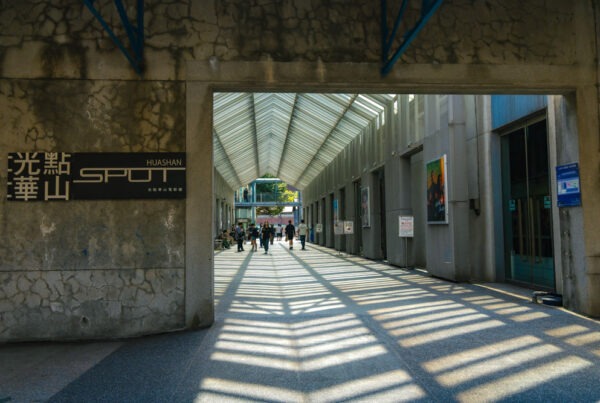Visit Keelung! The city, 40 minutes by commuter train northeast of Taipei City, is a blue-collar harbor town visually characterized by ships, container trucks, narrow streets, and old houses. The city is predominantly industrial, but does indeed have a compelling collection of scenic attractions as well. Travel in Taiwan recently did visit Keelung, going to locations that artist Wang Chieh, who lives in the city, has beautifully depicted in his paintings and written about in one of his books.
Text: Owain Mckimm, Photos: Maggie Song

Keelung Harbor
Wang Chieh is a Keelung-based artist best known for his landscape paintings using watercolors and ink. He studied painting in Spain for many years, attaining his Ph.D. from the University of Barcelona. After returning to Taiwan in 2003 he began painting his hometown of Keelung, capturing the city’s character and beauty in bright, vibrant watercolors, several of which are showcased in his book “A Painter’s Guide to Keelung.” Other publications include “Paintings of My Time in Spain” and “Art Lessons on the Road.” Since his return he has also traveled the country documenting and painting the island’s places and people, and writing up his travels in a number of newspaper and magazine columns.

Keelung Harbor painting by Wang Chieh
Wangyou Valley
The sun is blazing as we arrive at a trail in eastern Keelung that will take us down a hill into Wangyou Valley – a rare sight in what is known as Taiwan’s rainy city. Slowly we descend the steps. Coastal plants cover the edges of the trail, their leaves thick and waxy to retain moisture in the salty sea air. Purple-headed thistles spring up among other wildflowers. White trumpet-nosed blooms cling to the steep cliffs. Bulbuls, white-eyes, babblers, and thrushes duck and weave among the dense thickets. Serpent eagles and goshawks soar above a coast that has been ravaged year after year, century after century by typhoons, monsoon rains, and crashing waves.

Wangyou Valley
Peppered, too, amongst the hills are remnants of Keelung’s military past: pillbox guard posts and fortified lookouts peep from the undergrowth, fighting a losing battle against Mother Nature. After climbing to the top of one of the valley’s several peaks, we see the small fishing harbor of Badouzi on the left beyond, while ahead of us stretches the wide expanse of the East China Sea.

Wangyou Valley painting by Wang Chieh
“When I was young,” Wang recalls in one of his books, “I brought a friend here who had just had his heart broken. Under a warm sun and with a cool breeze blowing, we lay down, watching the goshawks circling above the bay and birds shuttling back and forth through the long grass. In that moment, everything seemed buoyant. My heartbroken friend slept, his cares forgotten.” It should come as no surprise to anyone visiting this place that the characters used for the “wangyou” (望幽) in the valley’s name form a homophone for another Chinese term that means “forget your worries” (忘憂).
Heping Island
To the northwest of Wangyou Valley lies Heping Island. In 1626, the Spanish arrived on this island, declared it Spanish territory, and built a fortification – Fort San Salvador – on the southwestern side. The fort and any traces of the Spanish on Heping Island have, unfortunately, been largely lost to history, but a small snapshot of the island’s colonial years can be seen in the geo park on its northern side. Much like at nearby Yeliu (with its famous Queen’s Head Rock), the main attractions in the park are the divertingly shaped sandstone rocks along the sea’s edge.

Heping Island
Follow the path around the park and you’ll come across the Cave of Foreign Words, a 20-meter-long natural tunnel that pierces a small headland near the eastern edge of the park. Inside the cave there is, purportedly, some 17th-century graffiti left by the Dutch, who took over Fort San Salvador in the 1640s. One of Wang’s paintings of the island – an imitation of a 17th-century map engraving – is a tribute to the island’s now largely lost colonial history, though Wang admits that its details rely as much on his imagination as they do on hard archaeological evidence.

Mushroom rocks on Heping Island
Baimiweng Fort
One of several old fortifications perched upon the hilltops around Keelung, Baimiweng commands a spectacular view of both the harbor and the sea. The small, winding lane that leads to the fort is a bit difficult to find, even for Keelungers, says Wang, who, with a painter’s romantic eye, goes on to compare the challenging ascent up the narrow, twisting road to the journey up to the citadel of Évora Monte in Portugal. Reaching the fortifications, you’re confronted with a spectacular vista and four large semi-circular gun emplacements, each of which was capable in its time of hosting a 5.65-meter-long cannon able to fire a steel shell 8.8 kilometers at enemy battleships. Though the current fortifications date back only to the early 1900s, Wang writes that fortifications have been built on this location since the 17th-century colonial conflicts between the Spanish and the Dutch, a fact attested by the fort’s alternate name, Holland Castle. “From here the night view of the harbor is breathtaking,” Wang writes, “and on the other side, far out to sea, you can see freighters slowly entering the harbor, while further away still you can see the sun setting.”

Baimiweng Fort

Baimiweng Fort by Wang Chieh
Three Sisters
It would be almost sacrilegious of us to visit a harbor town like Keelung and not visit a seafood restaurant. One of Wang’s recommendations is the Three Sisters Eatery on Xiao 4th Road. “This eatery is a Keelung institution – if you haven’t eaten here, then you haven’t been to Keelung,” he writes. To describe the place as nondescript would be a severe understatement – the eatery’s name isn’t even on display. Inside, however, the place bustles with the clinking of beer glasses, the chatter of locals, and the scoffing down of good nosh.

Three Sisters restaurant

Three Sisters restaurant painting by Wang Chieh
“The first time I came here to eat, I commented to my friend how similar to a Spanish bar it was,” writes Wang. “Of course, I wasn’t speaking in terms of the décor, but the atmosphere, the food, the noise, the large local crowd, the price – all these reminded me of Spain.” We order a few dishes, including jellied fish skin, crispy fried oysters, and squid in five-flavor sauce. For a seafood-sceptic like myself this is all looking to be a bit much, but the food proves to be fresh, the flavors light, the textures firm, crisp, and chewy.

Assorted dishes at Three Sisters restaurant
Central Keelung & Harbor
“It’s difficult to imagine that Keelung was once a bay of mud flats and sand, with just a few scattered aboriginal settlements,” Wang writes. And nowhere is this truer than when you’re standing in the city’s center. As a busy, working container port, central Keelung is a churning organism of cranes and freight containers, trundling cargo ships and busy-bee tugboats. The narrow streets and alleys that creep out from the narrow central harbor can become, especially on weekends, breathtakingly crowded – a situation abetted by the fact that the nearby Miaokou Night Market is one of the most famous in Taiwan.

Miaokou Night Market
Lee Hu Cake Shop (李鵠餅店)
Lee Hu Cake Shop has been in business in Keelung since almost the time Keelung Harbor was opened. It used to be said “If you haven’t been to Lee Hu, you haven’t been to Keelung.” Lee Hu is a well-known, long-established brand and Keelung’s most famous cake shop.

Mung bean paste cake

Pineapple cake

Egg yolk cake
Add: No. 90, Ren 3rd Rd., Ren’ai Dist., Keelung City
(基隆市仁愛區仁三路90號) (close to Miaokou Night Market)
Tel: (02) 2422-3007, 2427-8007, 2423-5007
Hours: 9am ~9:30pm
Website: www.lee-hu.com.tw (Chinese)
The turbulence of the port and its environs is perhaps only equaled by the turbulent history of the harbor itself. The bay, situated in a position of prime strategic importance (for both trade and military purposes), was for centuries fought over by the Chinese, the Spanish, the Dutch, the Japanese, and even the French. Foreign powers and natives alike were both thwarted, writes Wang, by the tropical diseases that bred in the area’s then miasmal conditions – an atmosphere that is perhaps echoed in the heavy smell of diesel oil that accompanies any large congregation of ships.
Nonetheless, there is a serenity to be found here. Head to the decking at the south side of the harbor, where hundreds of wind socks, painted and modelled to resemble multicolored tropical fish, line the waterfront, and sit there watching the ocean-going cargo ships enter the harbor. As they gently drift and turn in to dock, silent and steady, you may get a sense that this place, so often ravaged by armed conflict over the course of its history, has finally found peace.

Keelung City seen from Shiqiuling Fort
To get to Keelung, take a train or intercity bus from Taipei. Both trains and buses are frequent, and the journey takes 40-50 minutes. To get to Baimiweng Fort, take the No. 301 bus from Keelung City Bus Station (near the train station) to Taibai Villa, then head up Lane 37 of Guanghua Road. Baimiweng is at the top. To get to the Heping Island geo park, take the no. 101 bus to Hepingdao Park. To get to Wangyou Valley, take the 103 to the National Museum of Marine Science and Technology stop. Or take a train from Taipei to Ruifang, switch to the Shen’ao Line, and take the train to the National Museum of Marine and Science Technology (NMMST) Station. A free shuttle bus travels frequently, on both weekdays and weekends, from both the museum entrance and the train station to Wangyou Valley. The Three Sisters Eatery is located at 7 Xiao 4th Road, a short walk from Keelung Railway Station.
About the author













